Choosing the Best Skateboard for New Riders
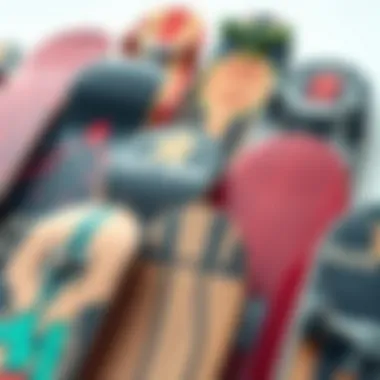
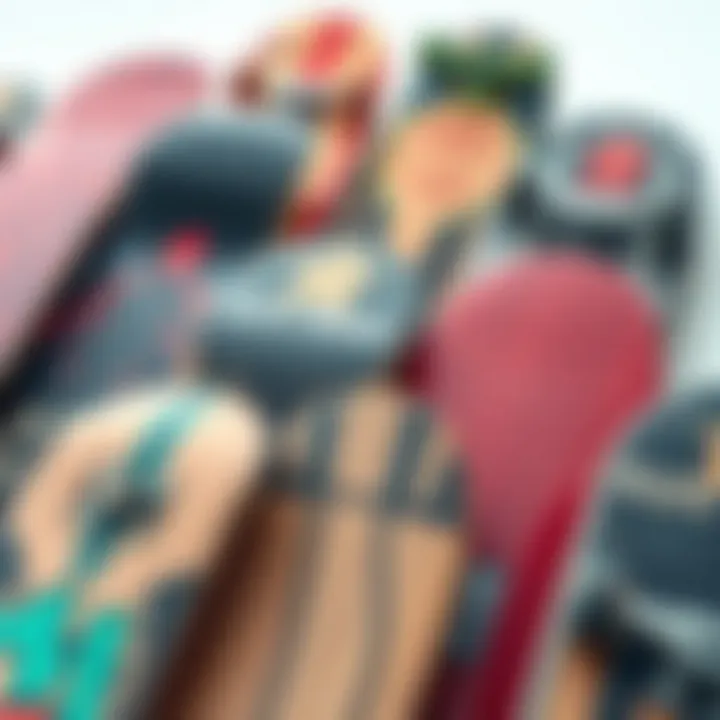
Intro
When someone embarks on the journey of skateboarding, it can feel like standing at the foot of a steep hill, staring up at the slopes of possibility and potential. A skateboard isn’t just a mode of transportation; it's a bridge to a world of creativity and self-expression. With various options available, selecting the right skateboard can feel overwhelming for beginners. This guide aims to clarify key considerations and demystify the process, making it easier to choose the skateboard that suits your needs.
Understanding the nuances of skateboards—from their types and materials to specific features—can significantly enhance your initial experience. Whether you’re planning to cruise down the street, master tricks, or simply enjoy the ride, this article offers well-rounded insights to help you navigate your options.
Skateboarding Techniques
Skateboarding isn't just about standing on a board; it's a dance of balance, agility, and creativity. Grasping basic techniques can make the difference between enjoying your time on the board or facing unnecessary frustration.
Essential Tricks for Beginners
Before you start landing flips, here are some tricks that lay the foundation:
- Ollie: The cornerstone of many other tricks. It involves popping the tail of the board to lift it off the ground without using your hands.
- Kickflip: This trick builds on the ollie, adding a flick of the front foot to rotate the board while airborne.
- Shuvit: A simpler move, where the skateboard spins 180 degrees beneath you without needing a jump.
Advanced Maneuvers for Experienced Skaters
For those who master the fundamentals and crave more challenge, these tricks push your skills:
- Heelflip: Similar to a kickflip, but flicking off the heel instead of the toes.
- Grind: Sliding along the edge of a rail or ledge can add flair to your routine but requires precision.
- 540 Spin: For those ambitious enough, this trick involves a full 540-degree rotation in the air, blending speed with skill.
Over time, these techniques will come together to form a repertoire that reflects your personal style.
Gear and Equipment Reviews
Choosing the right skateboard isn’t merely a matter of picking a design that catches your eye. It’s essential to consider different elements that affect performance and comfort.
Top Skateboards for Every Skill Level
- For Beginners:
- Intermediate Skaters:
- Advanced Skaters:
- Element Skateboards - Known for their durability and reasonable price.
- Bamboo Skateboards - Eco-friendly options that are lightweight yet sturdy.
- Girl Skateboards - Offers a good balance between performance and cost.
- Almost Skateboards - Renowned for innovative construction techniques.
- Santa Cruz Skateboards - A legacy brand with options designed for pros.
- Zero Skateboards - Developed for high performance and aggressive riding.
Protective Gear: Importance and Recommendations
Protective gear is as crucial as choosing the right board. Here’s what you should consider:
- Helmets: Don’t skimp on safety. Brands like Triple Eight and Pro-Tec offer robust options.
- Knee and Elbow Pads: Avoid road rash by opting for pads that fit snugly without losing comfort. Brands like 187 Killer Pads are trusted by many skaters.
- Wrist Guards: Wrist injuries are common among beginners. Look for supportive designs that still allow flexibility.
"The right gear is an armor that shields you as you explore your limit. Never discard its importance, no matter your skill level."
Understanding the skateboard landscape can make all the difference for newcomers. By grasping the core aspects of techniques and safety, beginners can enjoy a richer, more fulfilling experience on their skateboards.
For further information on skateboards and techniques, you can visit: Wikipedia, Reddit Skateboarding Community, and Skateboard Magazine.
The journey into skating is not just about wheels and wood; it's about embracing new challenges and finding joy in movement.
Prolusion to Skateboarding
Skateboarding is not just a means of getting from point A to point B; it serves as a cultural touchstone and a platform for self-expression. In this article, we explore the fundamental elements of skateboarding, especially geared towards novices looking to step onto a board for the first time.
Coming into this world, it's important to grasp the dynamics of skateboarding and why it captivates so many people. To many, it represents an adventurous spirit. From mastering simple pushes to performing intricate tricks, there's satisfaction in progressing through skills as oneself becomes more adept at balancing on wheels. Understanding skateboarding leads beginners to discover their unique style and, ultimately, to find a community that values both passion and creativity.
Notably, every skater’s journey varies. For some, it’s about cruising in the neighborhood, while others may aim for advanced tricks at skate parks. This diversity allows the sport to appeal to a wide audience, fostering a sense of belonging among practitioners.
The Rise of Skateboarding
The roots of skateboarding extend back to the 1950s, emerging as surfers sought a way to mimic their favorite hobby on land when ocean waves fell flat. Originally called "sidewalk surfing," the concept rapidly evolved, driven by a creative push from a burgeoning youth culture. By the 1970s, skateboarding started to gain significant traction, as manufacturers began producing equipment specifically designed for it.
Over the years, it has morphed into a varied sport, featuring a mix of street art aesthetics, acrobatic dance, and athletic prowess. The rise in popularity of skateboarding became an integral element of urban landscapes, with skate parks springing up and competitions enhancing its visibility.
Understanding the Appeal
The allure of skateboarding hinges on several factors. Foremostly, it provides a potent combination of thrill and freedom. Riders crave the sensation of speed coupled with the freedom to choose their path, unbounded by traditional restrictions of sports. When gliding down a road or launching off a ramp, the world can feel limitless.
Moreover, skateboarding encourages individuality. Much like an artist with a canvas, every skater has the chance to express themselves through their unique style, transforming mundane tricks into personal statements. Collectively, these elements fuse to create a community where camaraderie flourishes. Skaters share their experiences, techniques, and challenges, often spurring each other on towards greater achievements.
Why Choosing the Right Board Matters
When it comes to skateboarding, the right board plays a crucial role in shaping a skater's experience and skill development. Let’s delve into what makes the selection of a skateboard such an important process, especially for beginners.
Impact on Learning Curve
Choosing the right skateboard greatly influences the learning process. A beginner’s board should complement their weight, height, and skill level. If a board is too long or too short, it can hinder balance, making it more challenging for new riders to find their footing.
Here are some points to consider:
- Stability: A wider deck provides more stability, which can help beginners get comfortable on the board. It acts as a solid foundation to build fundamental skills like pushing off and turning.
- Maneuverability: Height and deck length matter too. A shorter board allows quick turns, but could be trickier for maintaining balance during initial efforts.
- Flexibility: Softer wheels can absorb bumps better, providing a smoother ride, essential for those first cautious attempts outdoors.
All these factors combined create a learning environment that can make or break the initial adventure into skateboarding. If a skater struggles unnecessarily due to an ill-suited board, their enthusiasm may wane, which is a shame considering how rewarding the sport can be.
Safety Considerations
Safety is paramount in any sporting activity, and skateboarding is no exception. The board you choose affects not only your ability to skate but also your safety while doing so. Starting with the right skateboard can prevent a multitude of accidents.
- Quality Materials: A sturdy deck that can withstand the rider's weight and impacts is non-negotiable. Cheaply made boards often break or splinter, which can cause falls and injuries.
- Grip Tape and Traction: Good grip tape on the deck keeps feet in place while rolling. A slippery board can lead to slips that could result in unfortunate spills.
- Wheels and Bearings: Wheels that are too small or too hard can lead to a bumpy ride, making it difficult to control the board—even for the experienced. Smoother wheels provide better control and allow beginners to build confidence.
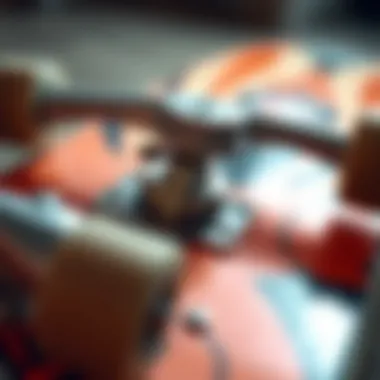

In essence, the correct board significantly minimizes the risks associated with learning how to skate. A safe, supportive setup encourages skaters to push their boundaries while keeping their wellbeing intact.
"The right board isn't just about preference; it's about laying the groundwork for a successful and safe skateboarding journey."
As we can see, the importance of selecting the right skateboard cannot be overstated. It directly impacts both the learning curve and the safety of new skaters, shaping their experience in meaningful ways.
Types of Skateboards
Choosing the right skateboard is like selecting the perfect pair of shoes; the fit and style must align with your personal journey. This section looks at the various types of skateboards available, each tailored for specific uses and preferences. Understanding these options can make the difference between an exhilarating ride and a frustrating one. Therefore, let's dig into the nuances of each type so beginners can head out with confidence and clarity.
Traditional Skateboards
Traditional skateboards are what many people first think of when the term ‘skateboard’ arises. They usually feature a rectangular wooden deck with a tail and nose, which allow for tricks, flips, and all that jazz. These boards can be found in various widths—generally between 7.5 to 8.5 inches—with a length of around 28 to 32 inches. The smaller size gives you nimbleness, while a wider board may enhance stability.
For beginners, traditional skateboards offer versatility. They're great for learning basic skills like pushing, turning, and performing some impressive tricks as you grow confident in your ability. The trucks on these skateboards connect the wheels to the deck and can usually be loosened or tightened, allowing skaters to find their personal preference regarding stability and maneuverability.
Longboards
Longboards have been a game changer for those seeking a smooth and stable ride, especially when it comes to cruising. Ranging anywhere from 33 inches to well over 50 inches in length, they are built for stability at higher speeds. The extra length provides a steadier base, ideal for downhill rides or commuting across longer distances.
One of the standout features of longboards is their design. Many have a drop-through deck where the trucks sit above the deck, lowering the center of gravity, making it easier to push and ride. If you're a beginner looking for comfort rather than doing tricks, a longboard might just be the ticket. They're also less likely to throw you off unless you hit a significant bump.
Cruisers
Cruisers can be likened to the friendly neighbor who always brings over the good snacks. These boards range in size but usually land somewhere between a traditional skateboard and a longboard. Generally shorter and wider than traditional boards, the length might be around 28 to 32 inches. They are perfect for quick trips to the store or leisurely rides in the park.
The wheels on cruisers are often soft and wide, which allows them to absorb shock from rough surfaces, providing that coveted smooth ride. If you're not planning on doing many tricks and just want to glide around, a cruiser gives you that relaxed vibe essential for enjoying the ride.
In summary, understanding the types of skateboards enables newcomers to identify what suits their needs, skill level, and style of riding. From traditional boards offering versatility to longboards that promise a steady glide, and cruisers ideal for casual rides, there's a board type tailored for everyone.
To learn more about the differences between skateboards, you can explore resources like Wikipedia for an expansive overview.
Key Components of a Skateboard
When embarking on the journey of skateboarding, understanding the essential components of a skateboard is crucial. Each part plays a unique role in the overall performance and safety of your ride. This section delves into the key components that contribute to a skateboard's function and feel, guiding beginners through the intricacies of deck materials, trucks, wheels, and bearings.
Deck Materials and Design
Choosing the right deck is one of the most critical decisions, as it affects not just how your skateboard looks but also how it performs. Skateboard decks are primarily made from various types of wood, with maple being the go-to option for many due to its durability and strength. Maple decks provide a fantastic pop, which refers to how well the board rebounds when you ollie or perform tricks.
However, you might also encounter decks made from bamboo or composite materials, which can be lighter and offer a different flex. For beginners, a standard 7-ply maple deck is often recommended because it combines sturdiness with some flexibility, suitable for developing basic skills.
Additionally, consider the shape and width of the deck. Wider decks offer more surface area, providing better balance, while a more narrow board can be easy to maneuver. It’s about finding that sweet spot that feels right under your feet.
Trucks: The Core Mechanics
The trucks of a skateboard are the metal fixtures that connect the wheels to the deck. These components are vital for turning, stability, and overall control. Trucks are adjustable, allowing riders to customize their turning capabilities. For beginners, mid-range trucks offer a perfect balance between stability and maneuverability, making it easier to learn how to carve and turn.
Typically, trucks come in different widths to match the width of the deck, ensuring a snug fit for optimal performance. Choosing the right height of trucks also plays a role; lower trucks provide more stability at high speeds, while taller trucks can offer more clearance for larger wheels.
Wheels and Bearings
Wheels and bearings are what set the skateboard in motion and can really impact your experience on the board. When it comes to wheels, there are a variety of sizes and hardness ratings to consider. Softer wheels, often measuring around 78A to 87A on the durometer scale, grip the surface better and create a smoother ride, especially over rough terrains. Harder wheels, with a rating of 88A and above, are faster but tend to offer a bumpier ride.
Bearings, usually rated by the ABEC standard, determine how smoothly the wheels spin. Higher-rated bearings generally roll faster but can be less tolerant of dirt and grime. For beginners, standard ABEC 5 bearings strike the right balance, providing good speed without needing constant maintenance.
"Understanding your board's mechanics isn’t just about performance; it significantly enhances your riding experience."
In summary, recognizing the importance of the skateboard's components is critical for any new skater. From the deck and its materials to the essential mechanics of trucks and the wheels, every element plays a role in achieving a fantastic ride. By carefully selecting these components to fit your style and preferences, you set the foundation for a more enjoyable and successful skateboarding experience.
Making Sense of Board Sizes
Choosing a skateboard isn’t just about the design or the brand. One of the more crucial but often overlooked aspects is understanding board sizes. This involves looking at width, length, and how these dimensions correlate with the rider’s body type. Grasping these elements will significantly influence not just comfort but also your overall skating performance.
Width and Length Considerations
When it comes to skateboards, one size does not fit all. The width of the board plays an essential role in how stable you feel, how easy it is to control, and even your tricks. Wider boards provide more surface area for your feet, which can be great for beginners who are still finding their balance.
Consider this:
- Widths typically range from about 7.5 inches to 8.5 inches. If a board is too narrow, your feet may overlap or feel cramped. On the flip side, too wide can lead to awkward movements.
- Length also matters. While less critical than width, the length of the board impacts your ride. Longer boards cater to cruising and stability, while shorter ones lend themselves to tricks and tight turns.
Here’s a helpful comparison of board widths:
- Narrow Boards (7.5 - 7.75 inches): Ideal for technical tricks and street skating.
- Medium Boards (7.75 - 8.25 inches): A good balance for both street and park skating, allowing for versatile use.
- Wide Boards (8.25 inches and above): Best for cruising, downhill riding, or those needing extra stability.
Choosing Size Based on Skater's Age and Weight
The rider's age and weight should not be disregarded when selecting a board. These factors significantly influence which size will suit best. A small child may comfortably manage a narrower board, whereas a heavier adult would require a wide one for appropriate support and balance.
- For Kids: 7.0 to 7.5 inches is often recommended for younger beginners or those below 100 lbs. It provides the lightweight feel they need to maintain balance while learning the ropes.
- Teens and Adults: Ranging from 7.75 to 8.5 inches depending on body weight. Specifically, if you weigh over 150 lbs, a wider board, such as one above 8.0 inches, can offer better support.
In summary, selecting the right board size is paramount. A few inches can make a world of difference. Just remember: being comfortable on your skateboard can lead to more enjoyable rides and quicker learning curves.
"Selecting the right skateboard is not merely a decision about preferences; it’s a decision that can shape the future of your skateboarding experience."
For further reading and to better understand skateboard sizing, check out Skateboarding: The Ultimate Guide for more detailed information.
Choosing the Right Setup
When it comes to selecting a skateboard, the setup is one of the most crucial aspects to think about. This choice can indeed make or break your experience on four wheels. A skateboard’s setup includes the board itself, the trucks, and the wheels, each influencing how you ride and perform various maneuvers. Understanding the importance of craftsmanship and compatibility among these elements will help you find the right balance as a beginner.
Identifying Your Skateboarding Style
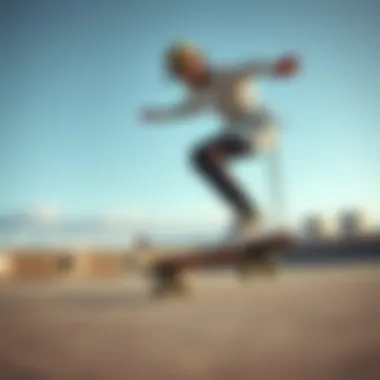
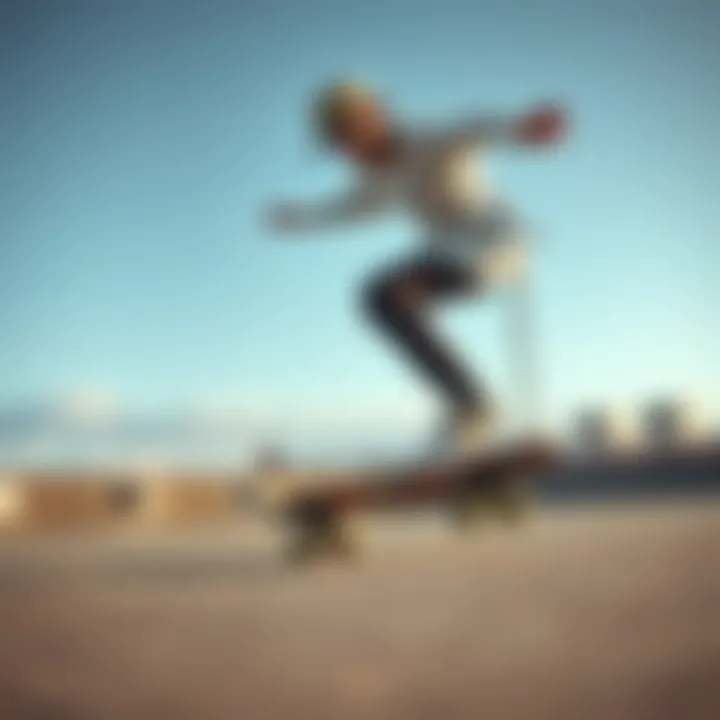
Fitting your skateboard to your style includes reflecting on how you envision riding. Some folks lean toward street skating, while others might prefer cruising or even vert skating. Each style demands different setups. For instance, if you are drawn to performing tricks on curbs and rails, a traditional skateboard with a narrower deck and harder wheels might be your best option. On the flip side, if you see yourself gliding smoothly along the pavement, a longboard could be your sweet ticket.
- Street Skating: Look for a deck that is lightweight, trick-friendly, and stable, usually around 7.5 to 8 inches wide.
- Cruising: Opt for a wider deck with softer wheels that absorb bumps, usually greater than 8 inches.
- Vert Skating: Seek a board that stands tall with a wide stance, helping you stay sturdy during aerial maneuvers.
Before you make your decision, take a moment to really think about where you want to ride and what skills you aim to develop.
Considering Terrain Types
The terrain you’ll be riding on weighs heavily on your board choice. Different environments demand different features in your setup. Rough sidewalks, smooth pavement, and skate parks each present unique challenges.
- Rough Terrain: Soft wheels in a larger size can help you conquer uneven surfaces without jarring your joints. A cruiser or longboard might handle these conditions better.
- Smooth Pavement: Harder wheels will glide like butter on a hot day. A street skateboard is suitable here, providing that nimbleness needed for performing tricks.
- Skate Parks: If you're tackling ramps, a board that is designed for vert or a street setup can give you the agility and stability to nail your tricks.
In essence, understanding the terrain where you’ll spend most of your time can guide your equipment choices. As a beginner, knowing your environment helps weed out setups that are simply not fit for your intended use.
"Choosing the right setup not only enhances your skating skills but also significantly influences your enjoyment and safety on the board."
Taking the time to evaluate your skateboard setup, style, and the surrounding terrain will position you to develop your skills effectively, ensuring that your journey in skateboarding is both enjoyable and rewarding.
Budgeting for Your First Skateboard
Setting a budget for your first skateboard is crucial. Diving into skateboarding can be exhilarating, but it's easy to get swept away in excitement and overspend. A well-thought-out budget helps you navigate the vast selection of skateboards without breaking the bank. Knowing what you can afford ensures that you’ll get a setup that fits your skill level and needs while keeping your wallet intact.
When budgeting, consider not just the skateboard itself, but all the necessary accessories. Think about safety gear—helmets, knee pads, and elbow pads. These items are just as important as the board to ensure a safe skating experience. A good starting point is setting aside at least an additional 30% of your skateboard's cost for essential safety equipment.
Also, factor in potential extra costs for maintenance or upgrades if your interest in skating grows. This forward-thinking helps avoid any surprises later on.
Understanding Price Ranges
While it may seem straightforward, understanding the price ranges of skateboards can be somewhat perplexing for newcomers. Skateboards typically range from low-end to high-end models, and prices can fluctuate based on quality and brand. Here's a breakdown of what to expect:
- Beginner Boards: These usually fall between $50 and $100. They often compromise on some features but are perfectly acceptable for novices.
- Mid-range Boards: Priced between $100 and $250, these boards tend to provide better durability and performance and are ideal for those willing to invest a little more.
- High-end Boards: Boards costing above $250 cater to serious enthusiasts and those with specific requirements, like professional-grade performance.
When selecting a skateboard within your budget, consider how committed you are to the sport. If you plan to skate regularly, investing a little more might serve you better in the long run.
Factors Affecting Price
- Material: High-quality woods or composites usually lead to higher prices.
- Brand Reputation: Established brands may charge a premium for their products.
- Customization: Custom setups will always cost more but are often worth it.
Investing in Quality vs. Cost
Not all boards are created equal, and sometimes, a lower price comes at the expense of performance and safety. Investing in quality is about weighing how much you are willing to spend against how often you’ll be using the skateboard.
While a highly-priced board may have all the bells and whistles, here are key considerations to keep in mind:
- Durability: A quality skateboard will withstand wear and tear much better than a cheaper option.
- Performance: Components like wheels, bearings, and trucks significantly affect ride quality. Poor-quality parts can hinder your learning process.
- Resale Value: High-quality boards often retain better resale value. If you ever decide to upgrade, it’s easier to recoup some of your initial investment.
Remember that diving into skateboarding doesn't have to be an expensive affair. It’s possible to find decent boards that fit your budget without skimping on quality. Just keep your eyes peeled for special offers or bundles that include safety gear, as these can give you more bang for your buck.
"Investing smartly in a skateboard can set the stage for a rewarding skating journey."
Where to Buy Your Skateboard
Choosing where to buy your skateboard is just as important as selecting the right board itself. This decision can affect your overall experience, both in terms of getting the right gear and ensuring you receive proper support when needed. With a wealth of options—online platforms, local shops, and major retailers—navigating this landscape can feel overwhelming. Each option offers its own set of advantages and challenges that beginners must consider carefully.
Online vs. Brick-and-Mortar Shops
Alright, let’s dive into the world of shopping. Online stores have set the bar high with their expansive selections and competitive prices. It’s like ordering a took-to-your-door pizza; you can browse at your fingertips and find a wealth of options. Websites like Amazon or specialized skate shops like Skate Warehouse or Tactics provide a range of products, from complete skateboards to individual components.
On the flip side, buying from a brick-and-mortar shop offers a uniquely immersive experience. You can physically examine the boards, test the wheels, and even engage with knowledgeable staff. They can provide insights and recommendations based on your skill level and intended use. Being able to touch and feel the board can make a world of difference, especially as a beginner.
When considering where to buy, here are some points to keep in mind:
- Convenience: Online shopping lets you browse from home, while physical stores offer real-time assistance.
- Choice: Online platforms often have a larger inventory, but local shops can provide specialized advice.
- Return Policies: It's crucial to check the return policies. Online purchases may have restocking fees or shipping costs, while local shops generally facilitate easier exchanges.
“The right board can make the world of difference, but the right buying experience can solidify your passion.”
Local Skate Shops vs. Major Retailers
Now, diving deeper, let’s weigh the pros and cons of local skate shops against major retailers. Local skate shops are often the heart of the skating community. They usually cater specifically to skaters and have an intimate understanding of what gear works best for local terrain and styles. Staff at these shops are not just employees; they’re often skaters themselves. Their passion shines through as they guide newcomers through the maze of choices.
Major retailers, like Walmart or Target, may offer lower price points, but they lack the specialized insight you’d get from a local expert. These stores stock products on a broad scale, which sometimes doesn’t cater well to the nuanced needs of skateboarders. Often, selections might not include quality brands that serious skaters appreciate.
Here are some considerations:
- Support Local: Buying from local shops boosts the community and can lead to finding new skating partners.
- Expert Advice: Local stores provide guidance that's often tailored to the local area or specific boards.
- Warranty and Service: Local shops may provide better post-purchase support, like tuning up or fixing your board.
Maintaining Your Skateboard
Keeping your skateboard in good shape is more crucial than you might think. First off, maintenance affects not just the performance of the board but also your overall skateboarding experience. A well-maintained skateboard can prevent accidents, increase its lifespan, and even make it feel more responsive. If you think about it, your skateboard is a complex machine, and like any machine, it requires regular upkeep to ensure everything runs smoothly. When you’re starting out, learning how to maintain your skateboard is just as important as learning to ride it.
Regular Maintenance Practices
So, what does regular maintenance entail? It’s not just about giving your skateboard a wash. On a basic level, several key practices should be integrated into your routine.
- Check the Deck: Periodically inspect the deck for any cracks or delamination. If you notice stress marks, it might be time to reconsider your board.
- Inspect the Trucks: The trucks play a significant role in how your skateboard handles. Ensure that the trucks are tightened properly and check for signs of wear and tear.
- Clean the Bearings: Dirt and grime can accumulate in the bearings, affecting how smoothly they spin. If you start hearing odd noises during rides, it’s time to clean them. You can use bearing cleaners or simply soak them in isopropyl alcohol before thoroughly drying them.
- Maintain Wheel Condition: The wheels should be checked for flat spots or excessive wear. If they feel rough or are uneven, consider rotating them or replacing as needed.
- Tightening Nuts and Bolts: It may not seem like much, but regularly checking and tightening the screws and nuts can make a world of difference.
A good rule of thumb is to perform maintenance every couple of weeks or after every significant riding session. Get into the habit of checking your skateboard; it can save you time and money down the line.
"Better safe than sorry. A little maintenance goes a long way in preventing a bigger issue down the road."
When to Replace Components
Even with diligent care, some skateboard components wear out over time and need replacing to ensure you stay safe while riding. Knowing when to swap out parts is key to maintaining performance.

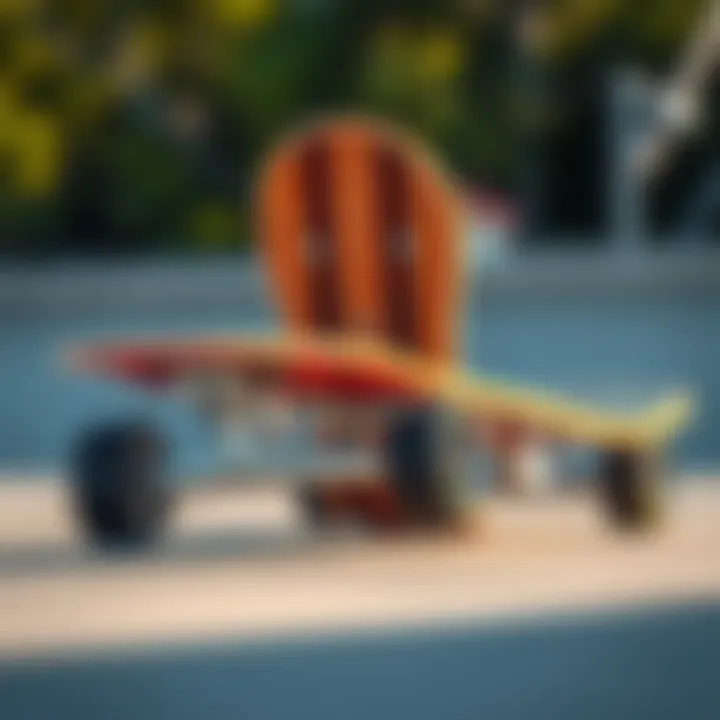
- Wheels: If your ride becomes bumpier, or if the wheels feel uneven when they spin, it might be time to get new ones. Flat spots are an obvious sign they need a change.
- Bearings: If maintenance doesn't resolve grinding sounds or they feel sluggish, replacing your bearings becomes necessary.
- Trucks: Visible damage such as cracks or bends might mean it’s time for new trucks. Worn cups on the truck can lead to instability.
- Grip Tape: If your grip tape is peeling or worn, it compromises your foot placement and stability. Re-gripping is straightforward and essential for consistent control.
To wrap it up, keeping up with your skateboard’s maintenance not only enhances performance but also helps prolong its lifespan. Familiarity with the signs that indicate a component needs replacing will also keep you safe. By taking these steps, you're not just protecting your skateboard; you're investing in your own riding journey.
Learning Basic Skills
For anyone embarking on their skateboarding journey, mastering the fundamental skills is non-negotiable. It forms the bedrock of a skater's development and ensures a safer, more enjoyable experience on the board. Before diving into tricks or cruising down the road, beginners must familiarize themselves with the basic maneuvers that set the stage for further progress.
Learning basic skills is like laying the foundation of a house; without it, everything else is at risk. The essential maneuvers not only build confidence but also enhance coordination and balance. A strong grasp of these fundamentals can significantly impact a beginner's ability to evolve into more advanced techniques.
Moreover, the initial focus on basic skills encourages a mindset that values patience and practice. Skating is not merely about gliding; it entails understanding the dynamics of movement, weight distribution, and board control. This understanding is pivotal as it mitigates the possibility of injuries and enriches the overall experience. Keeping safety in mind while developing skills fosters a healthy attitude towards the sport, nurturing longer-term enthusiasm and involvement.
Essential Maneuvers for Beginners
- Balancing: This is crucial as beginners stand on their boards. Start by simply standing still, engaging the core to help maintain equilibrium. A little sway is normal; the key is learning to control it.
- Pushing Off: Place one foot on the tail while the other pushes against the ground. This simple motion sets the groundwork for forward movement and introduces the concept of power application. It's all about getting into a comfortable groove, finding a rhythm that feels natural.
- Turning: Beginners should learn to shift their weight to turn the skateboard. Leaning slightly in the direction of the turn while applying pressure to the edge of the board will allow for smooth transitions. Remember, it’s not just about turning the board; it’s about executing fluid motions.
- Stopping: Always a practical skill, the most common method is called the foot brake. Simply drag the back foot on the ground to reduce speed gradually. As confidence builds, practicing the heel drag or using the tail can provide more stopping options.
Focusing on these basic maneuvers, one can gradually develop a better understanding of control over the board. Becoming familiar with the physics behind these skills—how inertia, friction, and balance interact—can offer valuable insights into performance. As the saying goes, practice makes perfect. The more time committed to these skills, the more comfortable and fluid skating will become.
Progressing Beyond the Basics
Once the essentials are well-practiced, it’s time to advance. Progressing beyond the basics marks a critical stage in a beginner's journey. Setting realistic goals will help maintain momentum. Progressing involves exploring a variety of maneuvers, adding complexity, and experimenting with personal style.
- Ollie: The cornerstone of many tricks, the ollie involves popping the tail and drawing up the front of the board simultaneously. It's about timing and coordination. At first, it may feel awkward, but keep at it!
- Kickturns: This maneuver broadens turning capabilities and is often the bridge to doing tricks. Start by rolling and shifting weight to the rear foot while simultaneously turning the front truck slightly up. This skill requires practice, but it allows for sharper and more stylish turns.
- Shuvits: Introducing rotation, this trick sends the board spinning in a complete circle. The mechanics involve popping the tail while pushing outwards with the back foot. Nail this, and you add flair to your style without even needing to leave the ground.
- Board Slides: A practice in balance and control, board slides can strengthen confidence while riding on ledges or rails. As balance improves, this trick combines creativity with solid skill execution.
Safety Gear and Precautions
Selecting the right skateboard isn’t just about choosing the type and size; it’s equally important to prioritize safety gear and precautions. Skateboarding can be an exhilarating experience. However, with that excitement also comes risks. Fortunately, proper safety gear can greatly reduce the chance of injury, making the learning process smoother and more enjoyable.
Essential Safety Equipment
When it comes to gearing up for skateboarding, several pieces of equipment are non-negotiable. Here’s a look at the essentials:
- Helmet: This is the most crucial piece of equipment. A high-quality helmet should fit snugly and be certified for impact protection. A helmet can mean the difference between a minor bump and a serious head injury. Look for features such as ventilation and lightweight materials for comfort.
- Wrist Guards: These help to protect against wrist injuries, which are common among beginner skaters. They support the wrist joint and might absorb shocks from falls.
- Elbow and Knee Pads: Both are vital for maintaining your joints' integrity. Elbow pads take the brunt of falls while learning to balance or turn. Knee pads support proper knee performance, especially when you’re trying tricks.
- Skate Shoes: Investing in shoes designed specifically for skateboarding can enhance grip and control on the board. They often feature a flat sole for better board feel and cushioning for impact absorption.
- Padded Shorts: While not essential, padded shorts can provide an extra layer of safety for your hips and tailbone, especially for those who are just starting and may be more prone to falls.
These items not only protect you from injury but also boost your confidence as you learn new skills. It’s a simple idea: the safer you feel, the more willing you are to push your limits.
Understanding Risks in Skateboarding
Skateboarding, inherently adventurous, comes with its fair share of risks. Understanding these risks is crucial for mitigating them effectively. Here are some of the main dangers to be aware of:
- Falls: This can happen even to the most experienced skateboarders. Beginners can easily lose balance, leading to falls that could result in scrapes, bruises, or worse. Learning how to fall safely can also lessen the impact of a tumble, but the right gear is essential.
- Road Hazards: Whether you're skating on the sidewalk or in a skate park, be vigilant about your surroundings. Objects like rocks, cracks in the pavement, or wet spots can cause unexpected wipes.
- Traffic: If you're skating on roads, be aware of the potential dangers posed by moving vehicles. Knowing the rules of the road and being alert to your environment can prevent serious accidents.
- Crowds: Busy areas can pose risks as well, especially if you're trying to navigate through pedestrians. Always give others plenty of space, and if you're at a skate park, be mindful of other skaters.
Ultimately, the goal is to recognize these risks and remain proactive in your approach. Prioritizing safety, using the right gear, and being aware of your surroundings helps you focus on enjoying the skateboard experience to the fullest.
Remember: "An ounce of prevention is worth a pound of cure." Protective gear isn’t merely an accessory; it’s a fundamental part of your skateboarding journey.
Community and Culture
When it comes to skateboarding, the community and culture surrounding the sport are as integral as the boards themselves. These elements foster an environment that encourages growth, support, and shared experiences among beginners and seasoned pros alike. Being part of a skateboarding community enriches the learning process, instills a sense of belonging, and provides a platform for collective progress.
The Role of Community in Skateboarding
Skateboarding transcends the act of riding on a wooden plank with wheels attached; it is deeply interwoven with a culture that values creativity, individuality, and a non-conformist spirit. A welcoming community often becomes the backbone for newcomers, guiding them through the initial hurdles.
The bonds formed between skaters often stem from shared challenges and triumphs. For beginners, finding a local skatepark can be a game changer. These parks are not just physical spaces; they serve as hubs where skaters gather, exchange tips, and motivate one another. A skater who struggles with balancing can learn so much simply by observing a more experienced skater's technique. The camaraderie that builds—sometimes through small talk after a trick lands successfully or a helping hand when someone falls—fuels each rider's passion.
Moreover, online forums and platforms like Reddit and Facebook groups provide additional avenues for connection and learning. These platforms allow skaters to share experiences, post questions, and showcase their progress, creating a supportive virtual community that extends well beyond local boundaries.
A vibrant skateboarding community welcomes all; it doesn’t judge who is faster or whose tricks are cleaner. Instead, it celebrates the thrill of learning and the love of skating.
Exploring Skateboarding Events and Competitions
One of the standout aspects of skateboarding culture is its events and competitions that bring together performers of all skill levels. These gatherings foster an environment characterized by friendly competition, inspiration, and education.
In many regions, local skate contests serve both to showcase talent and to build community spirit. Seeing participants push their limits—whether it's nailing a new trick or nailing their first ollie—creates a supportive atmosphere. Not only do such events spotlight individual achievements, but they also emphasize community effort as skaters cheer for each other.
Major events, such as the X Games or Street League Skateboarding, offer breathtaking displays of skill, dedication, and, often, artistic expression. Here, beginners can observe pro skaters' techniques, grasping both the mechanics of advanced maneuvers and the need for persistence. Events also provide opportunities to learn about gear, explore vendor booths, and, importantly, meet fellow skateboarding enthusiasts.
In summary, the community and culture of skateboarding play vital roles in shaping the journey of every skater. They open doors not only to enhanced learning but also to wider social circles, highlighting the beauty of shared passion for the sport.
Final Thoughts on Choosing a Skateboard
Making an informed decision when choosing a skateboard is a crucial step for any beginner. Having the right board can significantly shape the overall skateboarding experience, opening doors to skill development and enjoyment. There are several factors that come into play, from the type of skateboard to its specific components. Each element can profoundly impact comfort, safety, and ultimately, the proficiency gained during practice.
It's vital to consider personal preferences and individual goals in this selection process. Among the myriad of choices available, each skater might find that different characteristics resonate more profoundly with their unique skating style and needs. For example, whether the goal is to cruise around the streets, tackle ramps, or learn tricks, the board's design and components should align with that vision.
"Choosing the right skateboard is not just about selecting something that looks cool; it requires understanding what really works for your riding style and aspirations."
When skaters take the time to properly evaluate their options, they equip themselves with the knowledge necessary to make the best choice. This helps prevent common pitfalls, such as buying a board that feels uncomfortable or is ill-suited for their intended use. As they venture into the skateboarding realm, a thoughtfully chosen board can promote confidence, allowing them to focus on honing their skills rather than worrying about inferior equipment.
Furthermore, understanding various board features, like deck shape, wheel size and hardness, can positively affect performance. Not every board suits every skater, so knowing which aspects to prioritize can foster a more gratifying experience. Ultimately, selecting the right skateboard isn’t simply about riding; it's about creating a positive journey in a sport that continuously evolves.
Evaluating Personal Preferences
When it comes down to the nitty-gritty of selecting a skateboard, personal preferences can’t be overlooked. Each skateboarder has a different approach to their activity style, and factoring this into the decision can elevate the ride. Imagine aiming for a relaxing cruise on a longboard versus tearing up the local skatepark on a traditional skateboard. The vibe is distinctly different.
- Experience Level: Newbies might opt for a wider, more stable deck to gain confidence, while seasoned skaters may opt for something narrower aimed at tricks.
- Intended Tricks or Techniques: For instance, street skateboarding often favors a trick-focused board, while downhill riders might prioritize stability.
- Aesthetic Appeal: While the board must perform well, many skaters also have an eye on design. The board's look can resonate personally and enhance the emotional connection with the sport.
In any case, skaters ought to ask themselves what they truly want out of their board. Is it primarily function leading the choice, or does style play an integral role? This clarity of purpose will ensure a seamless fit.
Embracing the Journey Ahead
The journey into skateboarding is one filled with trials, camaraderie, and the sheer genius of personal expression. Once a skateboard is chosen, and the wheels start rolling, the true adventure begins. Every skater has something uniquely to offer this dynamic community, and beginning on the right foot can set the groundwork for lifelong enjoyment and growth.
As skills develop, it's crucial to stay open-minded and embrace new experiences. This means being willing to adapt not only one's skating technique but also considering future upgrades. The first choice may reflect a beginner's needs, but as they progress, their preferences and techniques may evolve over time.
Establishing a baseline with foundational skills helps build a skater's confidence. As they become familiar with their board, they may find themselves wanting to experiment with different styles of skateboarding or even join local groups or events. This transformation from novice to a confident skater can be incredibly rewarding.
In wrapping up, finding the right skateboard is just as important as the ride itself. It’s a vital step in unfolding a rich, passionate involvement with a sport that bridges creativity and athleticism. No matter the chosen board, embracing the journey with an open mind can lead to unforgettable moments and community connections.







